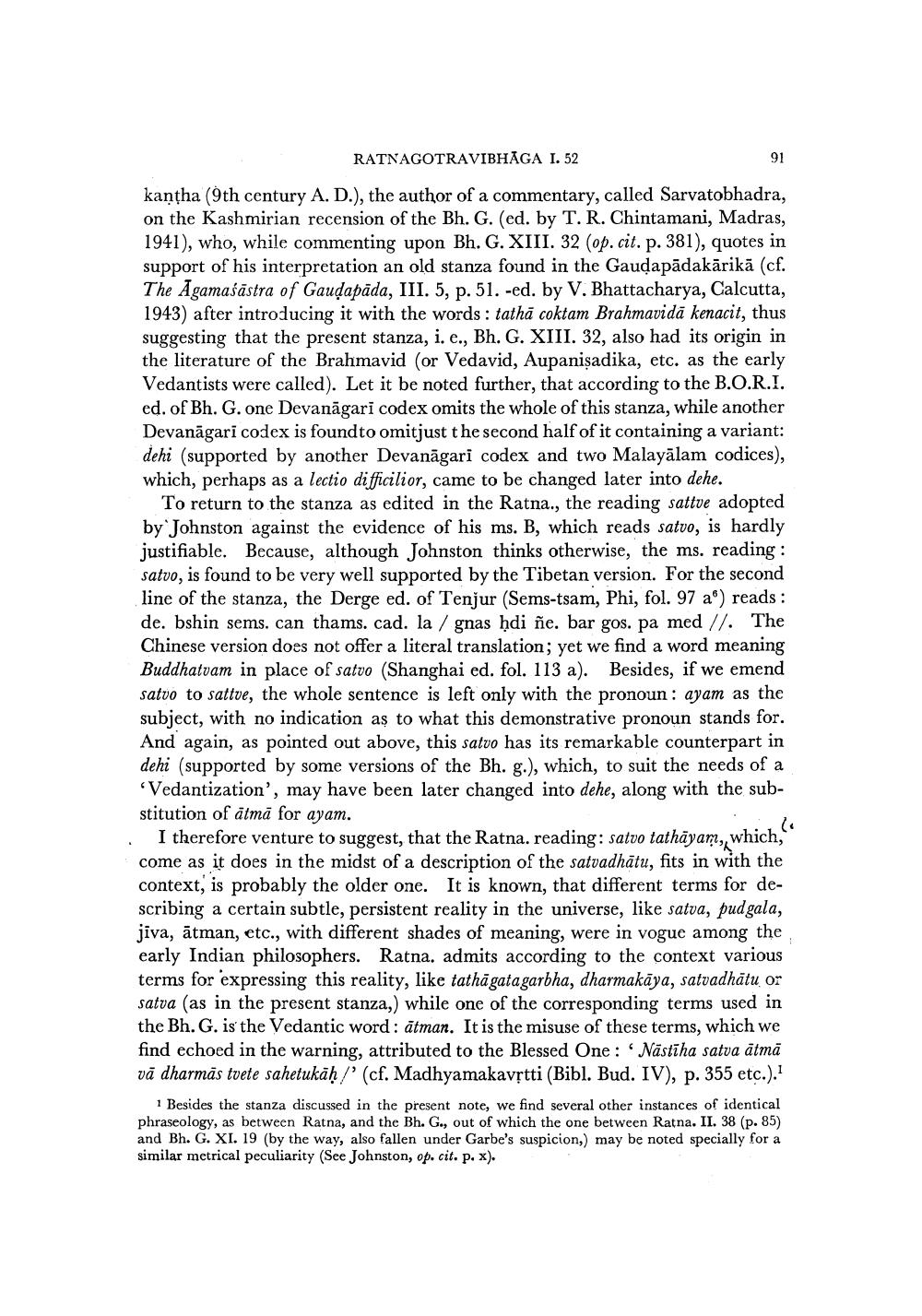________________ RATNAGOTRAVIBHAGA I. 52 91 kantha (9th century A. D.), the author of a commentary, called Sarvatobhadra, on the Kashmirian recension of the Bh. G. (ed. by T. R. Chintamani, Madras, 1941), who, while commenting upon Bh. G. XIII. 32 (op.cit. p. 381), quotes in support of his interpretation an old stanza found in the Gaudapadakarika (cf. The Agamasastra of Gaudapada, III. 5, p. 51. -ed. by V. Bhattacharya, Calcutta, 1943) after introducing it with the words : tatha coktam Brahmavida kenacit, thus suggesting that the present stanza, i. e., Bh. G. XIII. 32, also had its origin in the literature of the Brahmavid (or Vedavid, Aupanisadika, etc. as the early Vedantists were called). Let it be noted further, that according to the B.O.R.I. ed. of Bh. G. one Devanagari codex omits the whole of this stanza, while another Devanagari codex is foundto omitjust the second half of it containing a variant: dehi (supported by another Devanagari codex and two Malayalam codices), which, perhaps as a lectio difficilior, came to be changed later into dehe. To return to the stanza as edited in the Ratna., the reading sattve adopted by Johnston against the evidence of his ms. B, which reads satvo, is hardly justifiable. Because, although Johnston thinks otherwise, the ms. reading : satvo, is found to be very well supported by the Tibetan version. For the second line of the stanza, the Derge ed. of Tenjur (Sems-tsam, Phi, fol. 97 a(r)) reads: de. bshin sems. can thams. cad. la / gnas hdi ne. bar gos. pa med //. The Chinese version does not offer a literal translation; yet we find a word meaning Buddhatvam in place of satvo (Shanghai ed. fol. 113 a). Besides, if we emend satvo to sattve, the whole sentence is left only with the pronoun: ayam as the subject, with no indication as to what this demonstrative pronoun stands for. And again, as pointed out above, this satvo has its remarkable counterpart in dehi (supported by some versions of the Bh. g.), which, to suit the needs of a 'Vedantization', may have been later changed into dehe, along with the sub stitution of atma for ayam. . I therefore venture to suggest that the Ratna. reading: satvo tathayam,, which, come as it does in the midst of a description of the satvadhatu, fits in with the context, is probably the older one. It is known, that different terms for describing a certain subtle, persistent reality in the universe, like satva, pudgala, jiva, atman, etc., with different shades of meaning, were in vogue among the early Indian philosophers. Ratna. admits according to the context various terms for expressing this reality, like tathagatagarbha, dharmakaya, satvadhatu or satva (as in the present stanza,) while one of the corresponding terms used in the Bh. G. is' the Vedantic word : atman. It is the misuse of these terms, which we find echoed in the warning, attributed to the Blessed One : Nastiha satva atma va dharmas tvete sahetukah!' (cf. Madhyamakavrtti (Bibl. Bud. IV), p. 355 etc.).' 1 Besides the stanza discussed in the present note, we find several other instances of identical phraseology, as between Ratna, and the Bh. G., out of which the one between Ratna. II. 38 (p. 85) and Bh. G. XI. 19 (by the way, also fallen under Garbe's suspicion,) may be noted specially for a similar metrical peculiarity (See Johnston, op. cit. p. x).




